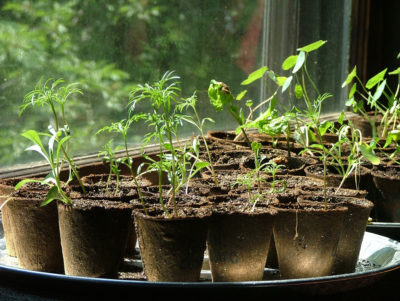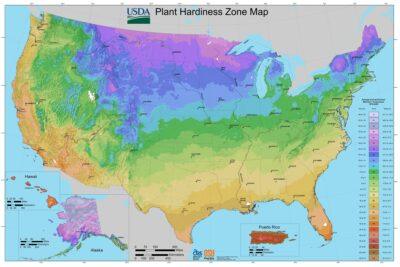If you are planning on finally getting your garden started come spring, you might be surprised that some of your planting actually should begin when it’s extremely cold out. Indoor planting, that is.
Seed-starting indoors has numerous benefits for all zones. It increases the success of your plants since they get a pretty easy start indoors, and it also allows you to extend your growing season. Actually, for some of the colder zones (like mine, zone 5) you pretty much have to start seeds indoors due to the short growing season. Certain types of vegetables or other plants simply take too long to reach harvest compared to the days we have between first and last frost.
What Zone Are You In?
First and foremost, you are going to need to figure out what zone you live in, since this dictates when you are going to need to start seeds as well as what seeds you can get away with planting outdoors or direct sown.
Look at the map on this page, and click on it. If you live on the cusp of two zones, generally you should go by the information on the zone with the shorter growing season just to be safe.
Start Your Spring Garden Now With This Complete Ready For You Kit
What Do You Want to Plant?
There are so many varieties of vegetables and fruits available to plant that it can make you feel a bit crazy. Now that you’ve figured out what your zone is, you’ll be happy to know that you can shop for seeds that will thrive in your particular area.
If you look at the back of a seed packet for a vegetable, much of the time there is information about whether the plant likes full sun, shade, how far apart to plant, etc. Online or print nursery/seed catalogs should have the same zone information.
If you are new to gardening, it is recommended that you start off small. Think about what you and your family eat on a regular basis, and plant those types of vegetables. If you’re big salad eaters, you’ll benefit from planting different lettuces and mixes. If you hardly ever eat squash, you might find it just wastes space in your garden when you could have planted something you enjoy.
(Quick Note: Sometimes you can get away with planting a vegetable that requires a warmer zone, but be warned that this plant is almost always going to die come winter, even if it’s a biennial or perennial.)
Ordering seeds online is easy and gives you a wider selection than you could find in your stores locally. I find that seed catalogs are always nice to have on hand as reference in future garden planning.
Getting Your Seeds Started
When I was new to gardening, I had a moment of panic when I realized I had to start seeds indoors due to my zone but had no idea WHEN I was supposed to start them. Start them too early and you’re going to have to deal with huge seedlings or, at that point, maybe even a small plant you’re going to have to transfer to a bigger pot. That would be a pain. Start too late and you might not achieve optimal harvest due to first frost.
Thankfully, there are plenty of resources out there for seed planting charts. These planting charts are very helpful and a great way to guide you on when to start what. Heirloom varieties of seeds with very long growing periods may need to be started just a bit earlier than the seed charts say, since many seed charts are based on growing averages of hybrids. If you are really uncertain, I recommend doing a search on Google (if you have a question, chances are someone else did, too) or contacting the nursery that sold the seeds and ask for their opinion.
Get Your Delicious Heirloom Tomato Kit Today
Seed Starting Supplies
Starting seeds indoors is easy-peasy once you’ve figured out when to plant and all that technical stuff. You are going to need just a few things:
- Mini pots or plastic starting trays
- Space for the seedlings
- Lights (possibly optional)
- Source of heat
- Soil
Pots
Plastic starting trays aren’t that expensive and are usually easy to just reuse for a few seasons. You can also find little peat pots that work well. With some peat pots you actually rehydrate in water, and it expands into a mini pot that you just pop your seed right into. Once the plant is ready you just put the whole thing into the ground in your garden. This makes planting super easy, but they are more expensive.
Also, you can use old newspaper to make tiny pots. Check out a tutorial here. Here in our garden we typically use old, cleaned mini milk cartons from a local school. They are a perfect size and the carton easily tears away when it’s time to plant outside.
New Natural Fertilizer Doubles Garden Production!
Space
This is kind of a no-brainer, but you need space for all those seedling trays. Since you are probably going to need artificial lighting (see below), a perfect way of storing the trays is on a shelving system, plastic or metal. You can then hang your lights right under each shelf so each level gets light.
Lights
Sometimes we don’t even need to use artificial light, but you’re going to really get optimal growth if you do. Grow lights can be a bit pricey, but I feel like they are worth the money. Invest in good fixtures and you’ll only need to replace the bulbs when they burn out.
Heat
Seedlings need to be kept warm. Some seedlings really need to be pampered and enjoy heat, such as tomatoes or peppers. Companies do sell large plastic heating mats that work well. They can be a bit expensive, however. You’ll have to weigh the pros and cons to see if it’s worth the investment for you. Using heat tape such as Flexwatt is less expensive, but you’ll need a thermostat. Otherwise, keep your seedlings in a warm location in your home.
Soil
Soil is very important when it comes to seed starting. Regular potting soil could be too dense and heavy for seeds, which makes growth slow and difficult for the plant. There are seed-starting soil mixes that work well, but they can be expensive. Some gardeners have success mixing a bit of sand with regular potting soil to loosen it up. If you are starting off with a small garden and are new to seed starting, go with an inexpensive generic brand of seed-starting soil from a local source.
After you have your seeds and your supplies, just wait for the date to start planting based on your chosen seed-starting chart. Keep in mind you might want to stagger planting on certain vegetables like salad mixes so you can harvest all throughout the growing season rather than having one giant harvest at the same time, every time.
Good luck with your seeds! If you have any seed starting advice or just want to share what you’ll be planting in 2015, please share in the comment section below.
Do you have any tips on starting seeds that you like share? Please leave them in the comment section below.



![Flower's Garden SECRET!! | MyCraft Family Minecraft Survival [Ep.3] Flower's Garden SECRET!! | MyCraft Family Minecraft Survival [Ep.3]](https://survivalcove.com/wp-content/uploads/2022/02/1645064494_maxresdefault-370x297.jpg)
























